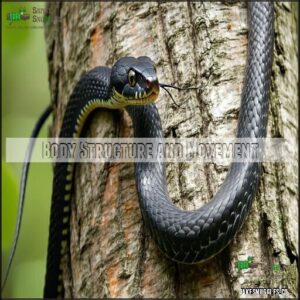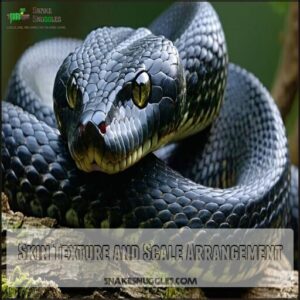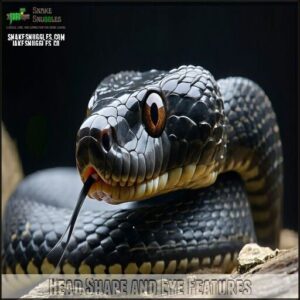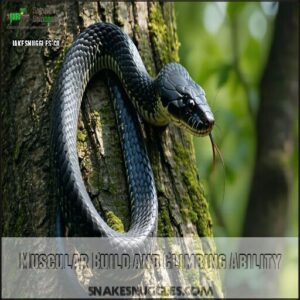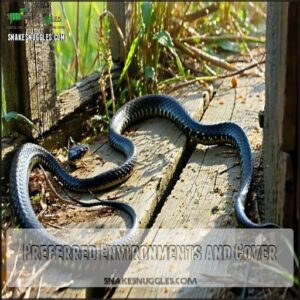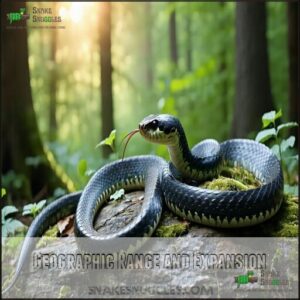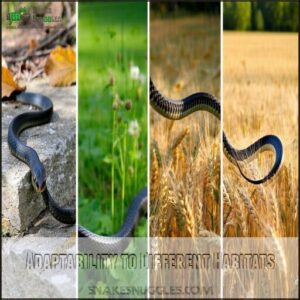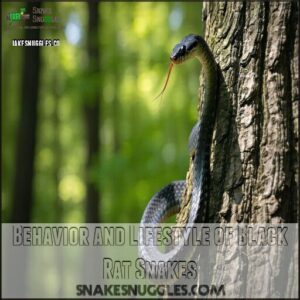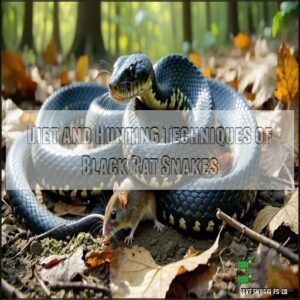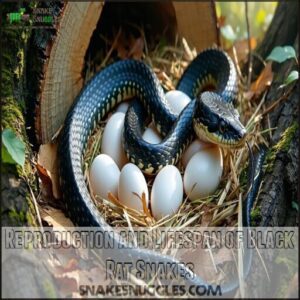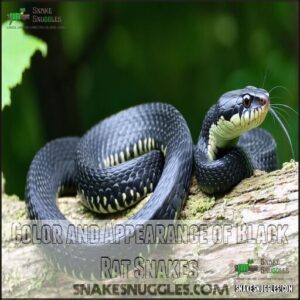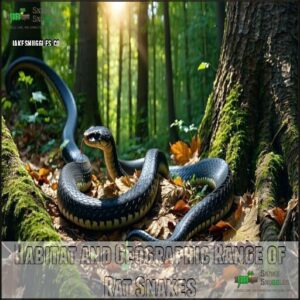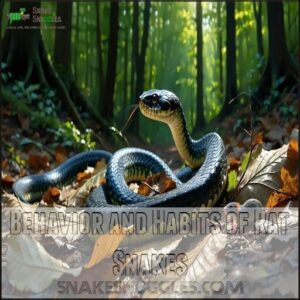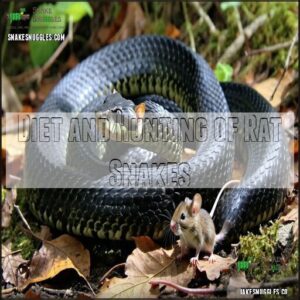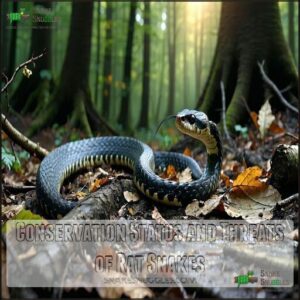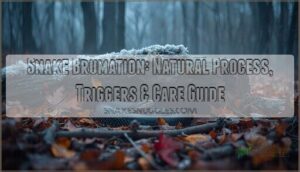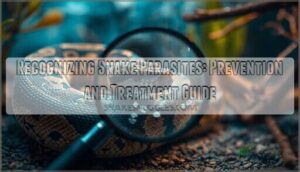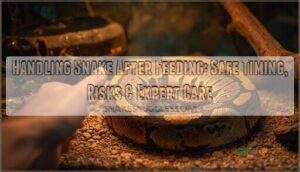This site is supported by our readers. We may earn a commission, at no cost to you, if you purchase through links.
 Here’s the 100-word quick answer:
Here’s the 100-word quick answer:
You’ll find black rat snakes are fascinating predators native to eastern North America.
These non-venomous serpents can grow up to 6 feet long, sporting a sleek, glossy black coat as adults.
They’re nature’s pest control experts, hunting rodents, birds, and small mammals with remarkable stealth.
Juveniles look quite different, wearing gray skin decorated with irregular brown spots.
You’ll spot them slithering through forests, rocky areas, and woodland regions, where they’re masters of camouflage.
Their incredible climbing skills and swimming abilities make them adaptable hunters.
These snakes aren’t just silent survivors – they’re living proof that even the most misunderstood creatures play a key role in our ecosystem’s delicate balance.
Table Of Contents
- Key Takeaways
- Physical Characteristics of Black Rat Snakes
- Habitat and Distribution of Black Rat Snakes
- Behavior and Lifestyle of Black Rat Snakes
- Diet and Hunting Techniques of Black Rat Snakes
- Reproduction and Lifespan of Black Rat Snakes
- Color and Appearance of Black Rat Snakes
- Habitat and Geographic Range of Rat Snakes
- Behavior and Habits of Rat Snakes
- Diet and Hunting of Rat Snakes
- Conservation Status and Threats of Rat Snakes
- Frequently Asked Questions (FAQs)
- What are some facts about black rat snakes?
- Are black rat snakes good to have around?
- Can a black rat snake hurt you?
- What to do if you see a black rat snake?
- Which rat is bigger brown or black rat?
- Do black snakes kill other snakes?
- How big can a black rat snake get?
- What is an interesting fact about the black rat snake?
- Are black rat snakes aggressive?
- Where do black rat snakes live?
- Conclusion
Key Takeaways
- You’ll find black rat snakes are master predators that help control rodent populations across eastern North America, playing a crucial role in maintaining ecosystem balance.
- These adaptable serpents can grow up to 7 feet long, with impressive skills like climbing trees, swimming, and using defensive mimicry to scare off potential threats.
- Black rat snakes aren’t venomous and typically shy, preferring to flee rather than attack when encountering humans. They’ll use tactics like tail vibration and releasing a foul odor to avoid confrontation.
- Habitat loss and human misunderstanding pose significant challenges to these remarkable snakes, making conservation efforts critical for protecting their populations and preserving their important ecological function.
Physical Characteristics of Black Rat Snakes
You’ll be amazed by the black rat snake’s impressive physical features that make it a master of stealth and survival.
Its long, sleek body stretches up to 7 feet, with shiny black scales and a muscular build that allows it to climb trees and move with incredible agility.
Body Structure and Movement
Navigate through the intricate world of black rat snakes, where their sleek, muscular body is a marvel of nature’s design.
These serpents boast an incredible Vertebral Column that enables remarkable flexibility and precise movement.
Their unique Body Proportions, combined with powerful Muscular Contraction mechanisms, allow them to climb trees, coil tightly, and strike with lightning speed.
With Arboreal Adaptation skills that minimize Scale Friction, they glide effortlessly across varied terrains.
Whether slithering through undergrowth or scaling branches, their snake anatomy reveals a perfectly engineered hunting machine.
Skin Texture and Scale Arrangement
After its muscular frame propels it through landscapes, the black rat snake’s scale morphology comes into sharp focus.
Its smooth texture and shiny black scales aren’t just for show—they’re survival tools.
Consider these key adaptations:
- Keeled scales enhance grip
- Smooth texture reduces friction
- Color variation camouflages movement
- Regular shedding refreshes protective layers
Nature’s design makes certain this serpent moves with unparalleled stealth and efficiency.
Head Shape and Eye Features
As the scales shimmer from the previous section, the black rat snake’s head shape emerges as a marvel of predator design.
Its wide, wedge-shaped head is a masterpiece of head morphology, perfectly crafted for sensory perception and predator evasion.
Round pupils offer keen eye size, allowing these hunters to spot the slightest movement.
Juveniles sport distinctive eye markings that aid in snake identification, while their subtle scalation patterns create an unparalleled camouflage.
A flickering tongue completes this sensory arsenal, gathering critical environmental intelligence with each subtle movement.
Muscular Build and Climbing Ability
You’ve seen their impressive head and keen eyes; now watch how black rat snakes become tree-scaling acrobats!
With remarkable muscle adaptation and skeletal leverage, these agile constrictors master arboreal locomotion. Their climbing speed and grip strength transform ordinary branches into superhighways.
Each muscular movement reveals nature’s engineering—a climbing snake that turns vertical challenges into effortless adventures, proving why they’re true wilderness gymnasts.
Habitat and Distribution of Black Rat Snakes
You’ll find black rat snakes thriving in a diverse range of habitats across eastern North America, from dense woodlands to suburban landscapes.
These adaptable predators can navigate through fields, forests, and rocky areas, showcasing their remarkable ability to survive and hunt.
They thrive in environments that span from sea level to the Appalachian peaks.
Preferred Environments and Cover
After exploring the black rat snake’s impressive physique, let’s peek into their world of preferred hideouts.
These slithery survivors are masters of adaptation, thriving in landscapes that offer protection and opportunity.
From rocky outcrops to forest edges, they’ll make themselves at home wherever shelter meets hunting potential.
- Silent shadows among woodland whispers
- Rustic barns brimming with rodent prey
- Sun-warmed stone crevices
- Dense green sanctuaries
- Forgotten farmland corners
Their habitat isn’t just a place—it’s a carefully selected kingdom where survival meets strategy, blending camouflage, comfort, and cunning in nature’s intricate design.
To guarantee they feel secure, consider suitable shelter options.
Geographic Range and Expansion
You’ve likely spotted these silent hunters across North America’s diverse landscapes.
From New England to Georgia, black rat snakes navigate regional boundaries with remarkable ease. Their snake distribution spans southern Canada to Central America, crossing rocky hillsides, deciduous forests, and farmlands.
Climate and geography shape their range, allowing these adaptable predators to thrive in multiple ecosystems.
Some snakes even use heat-sensing organs for survival.
Adaptability to Different Habitats
Black rat snakes can wiggle into almost any environment, proving they’re masters of urban adaptation and climatic tolerance.
Their incredible flexibility lets them thrive in diverse landscapes like a chameleon changing colors.
Check out where these serpentine survivors excel:
- Woodlands with lush undergrowth
- Farmlands teeming with prey
- Suburban neighborhoods offering hidden corridors
- Rocky terrain providing strategic shelter
- Ecosystems ranging from humid summers to freezing winters
These snakes don’t just survive—they conquer every habitat they encounter.
Forested Areas and Undergrowth
Rat snakes transform forest microclimates into their personal hunting grounds, slithering effortlessly through woodland terrains.
Their remarkable adaptability shines in diverse environments, where forest floor and canopy offer strategic advantages.
- Navigate dense undergrowth with serpentine grace
- Exploit edge effects for stealthy ambushes
- Camouflage within woodland’s intricate layers
These silent predators master every inch of their forest habitat, turning undergrowth density into a survival advantage.
Behavior and Lifestyle of Black Rat Snakes
When you encounter a black rat snake, you’ll be observing one of nature’s most fascinating and adaptable predators.
These remarkable creatures navigate their environments with incredible stealth, moving through woodlands and fields with a combination of nocturnal hunting skills and impressive climbing abilities.
That’ll make you marvel at their survival techniques.
Daily Life and Activity Patterns
When temperatures rise, these serpentine hunters adjust their daily rhythms to survive and thrive.
Their nocturnal nature guides their movements, strategically moving through landscapes under moonlit skies.
| Activity | Seasonal Pattern |
|---|---|
| Hunting | Primarily nocturnal |
| Basking | Daytime in spring/fall |
| Migration | Habitat-dependent |
| Shelter | Rocky crevices, tree bases |
Their adaptability guarantees survival across changing environments.
Social Behavior and Interaction
Within the intricate world of snake social dynamics, black rat snakes reveal surprising complexity beyond their solitary reputation. Their social behavior unfolds through fascinating interactions that challenge traditional perceptions:
- Communal hibernation creates unexpected interspecies bonds
- Pheromone trails serve as sophisticated communication networks
- Territorial disputes resolve through nuanced posturing rather than aggressive confrontations
During winter months, these serpents huddle together in shared dens, demonstrating remarkable adaptability.
When threatened, they release a pungent musk—a chemical defense that speaks volumes about their strategic survival mechanisms.
Understanding their defensive snake postures is important for interpreting their actions.
Their social hierarchy emerges subtly, with mating competitions and juvenile interactions painting a rich portrait of snake society.
Basking and Thermoregulation
Nature’s silent hunters harness sunlight, transforming cold rocks into personal heating stations with reptilian resilience.
Hey there, snake enthusiasts! Ever wondered how these slithery friends manage their body heat? Black rat snakes are masters of thermal regulation, strategically soaking up sunlight to stay energized and healthy.
Nature’s silent hunters, basking in sunlight—transforming cold rocks into personal solar panels of survival.
- Soak in the warmth like a reptilian solar panel
- Transform cold rocks into cozy personal heating stations
- Navigate seasonal changes with reptilian resilience
- Discover nature’s ingenious temperature control system
- Experience the silent survival magic of basking
Optimal temperatures drive their metabolism, with strategic microhabitat selection enabling them to thrive across diverse environments.
From sun-drenched logs to sheltered rocky outcrops, these silent hunters know exactly how to regulate their body heat.
Diet and Hunting Techniques of Black Rat Snakes
If you’ve ever wondered how a black rat snake transforms from a patient predator to a lightning-fast hunter, you’re in for a treat.
These incredible reptiles use a combination of stealth, ambush tactics, and powerful constriction to capture everything from tiny rodents to bird eggs, making them nature’s most versatile silent hunters.
Preferred Prey and Feeding Habits
You’re a master of culinary conquest in the wild!
Your diet spans a smorgasbord of prey: rodents, frogs, lizards, and birds’ eggs.
As a skilled constrictor, you adapt your prey selection to local availability, with small mammals topping your menu.
Your hunting frequency shifts with seasonal variations, making you a versatile predator.
Juvenile diets focus on smaller ectotherms, while adults excel at rodent control, striking with silent precision.
Ambush Techniques and Stealth
Black rat snakes are masters of camouflage, blending seamlessly into their habitat.
Using their keen sensory skills, they exploit silent movement to remain undetected while hunting.
These stealthy predators leverage natural cover, positioning themselves perfectly to ambush unsuspecting prey. Like patient hunters, they rely on precise strike strategies and strategic prey selection.
Their hunting techniques transform woodlands and grasslands into calculated hunting grounds, where rodent control becomes an art form. Each movement is deliberate, each moment carefully calculated for maximum hunting success.
Swift Strikes and Accurate Attacks
When hunting, rat snakes discharge lightning-fast strikes with pinpoint accuracy. Their hunting prowess relies on incredible snake agility and split-second timing:
- Freeze in perfect camouflage
- Calculate precise attack angles
- Launch explosive lunges
- Immobilize prey instantly
- Secure meal through constriction tactics
These silent predators transform from motionless statues to blur-like hunters, executing ambush predation with remarkable precision.
Their strike speed guarantees survival in the complex dance of predator and prey.
Diverse Diet and Opportunistic Hunting
You’ll be amazed by these serpents’ remarkable dietary flexibility.
Their prey constriction skills transform them into nature’s ultimate opportunistic hunters.
From rodents to bird eggs, rat snakes adapt their hunting strategies across diverse habitats.
Whether slithering through farmlands or forest edges, they’re master predators controlling pest populations with impressive dietary adaptations and surgical precision.
Reproduction and Lifespan of Black Rat Snakes
You’ll be fascinated by the intricate reproductive cycle of black rat snakes, where males engage in elaborate mating rituals during late spring and early summer.
These remarkable reptiles lay clutches of 6 to 24 eggs in carefully selected locations.
Ensuring the survival of their next generation through strategic nesting and incubation techniques.
Mating Rituals and Breeding Season
When snake romance kicks into high gear, male rat snakes commence on an intricate courtship dance. Tracking potential mates through pheromone trails, they engage in elaborate wrestling matches that determine breeding rights.
- Males compete fiercely through physical displays
- Seasonal timing triggers intense mating behaviors
- Subtle tail vibrations and body arching signal attraction
Late spring transforms forest floors into bustling dating scenes, with males maneuvering complex social hierarchies.
Their reproductive strategies aren’t just about passion—they’re carefully choreographed performances ensuring hatchling survival.
From May through June, these serpentine suitors pursue females with remarkable determination, turning snake reproduction into nature’s most strategic matchmaking event.
Female Reproductive Cycle and Egg-Laying
After spring’s passionate dance, female rat snakes commence on their reproductive journey.
They seek out cozy, hidden spots like rotting logs to lay their precious eggs.
Oviposition isn’t just a process—it’s survival’s masterpiece.
Depositing 5 to 30 eggs, these silent hunters make certain their genetic legacy continues, leaving hatchlings to navigate the world with nothing but instinct and raw determination.
Incubation Period and Hatchling Development
Nestled beneath warm underground shelters, black rat snake eggs transform during a delicate 5-7 week incubation period.
Temperature plays a pivotal role in hatchling development, guiding their emergence as independent predators.
About a foot long with distinctive gray and black patterns, these newborns instantly tap into survival instincts, swiftly hunting small rodents and lizards without parental intervention.
Lifespan and Survival Rates in The Wild
Nature deals a tough hand to black rat snakes, with their wild lifespan averaging 10-15 years.
Their survival hinges on addressing complex environmental challenges:
- Predator impact threatens young snakes from foxes, hawks, and raccoons
- Habitat quality determines long-term survival prospects
- Disease susceptibility reduces population resilience
- Human influence creates significant survival obstacles
Scientific tracking reveals surprising adaptability: some individuals exceed 20 years in captivity, demonstrating remarkable genetic diversity and survival strategies that help these silent hunters persist against overwhelming odds.
Color and Appearance of Black Rat Snakes
Sleek like obsidian, black rat snakes shimmer with nature’s perfect design—a midnight-dark predator built for survival.
When you first spot a black rat snake, you’ll be struck by its sleek, jet-black scales that shimmer like polished obsidian in the sunlight.
A jet-black serpent glides like liquid midnight, polished scales catching sunlight with primal grace.
With a muscular body stretching up to 8 feet long, these magnificent creatures boast a distinctive wedge-shaped head, large round eyes, and a white or cream-colored throat that contrasts beautifully against their midnight-dark exterior.
Shiny Skin and Scale Pattern
Imagine a black rat snake’s scales gleaming like polished obsidian, revealing nature’s masterpiece of scale iridescence.
From its sleek texture to intricate pattern variation, each shedding cycle renews its impressive shiny black coat.
The snake’s melanism genetics create a stunning visual that aids camouflage and movement.
| Characteristic | Description | Impact |
|---|---|---|
| Scale Texture | Smooth & Glossy | Enhanced Movement |
| Shedding Cycle | Regular Renewal | Skin Health |
| Pattern | Black Obsidian | Camouflage |
| Iridescence | Subtle Shine | Visual Appeal |
| Genetic Trait | Melanism | Survival Advantage |
Elongated Head and Keen Eyesight
With an impressive head shape that speaks volumes about evolutionary design, black rat snakes boast remarkable visual acuity.
Their elongated skull and large, round eyes create exceptional binocular vision—a critical hunting adaptation.
When you’re practicing snake identification, notice how their keen eyesight allows them to spot prey from remarkable distances.
These facial features aren’t just aesthetically intriguing; they’re precision instruments of survival in the wild.
Juvenile Coloration and Pattern
When young rat snakes emerge, their unique Juvenile Camouflage strategy unfolds through intricate Pattern Development. These serpents sport a beige backdrop decorated with bold brown blotches, creating a masterful disguise in nature’s landscape.
- Subtle side patches break up their outline
- Creamy-white bellies remain consistent
- Color Change occurs gradually
- Blotches Fading reveals their true identity
Their scale patterns serve as a brilliant survival mechanism, helping snake identification while protecting them from potential predators during vulnerable early stages.
Adult Coloration and Pattern
You’ll marvel at how black rat snakes transform from speckled juveniles to sleek, all-black adults.
Their Scale Iridescence catches sunlight, revealing subtle shifts in their Melanism Variation.
Regional Differences influence their Belly Patterns—some sport intricate white and black checkerboards, while others showcase hints of pink.
Their black scales aren’t just a fashion statement; they’re camouflage perfected.
Color Fading might hint at age, but these serpents remain masters of disguise.
Each snake tells a unique story through its distinctive scale patterns, blending science with natural artistry.
Habitat and Geographic Range of Rat Snakes
Have you ever wondered where black rat snakes thrive in the wild, silently slithering through diverse landscapes?
These remarkable reptiles call the eastern United States home, seamlessly adapting from dense forests and rocky woodlands to farmlands and even suburban backyards, showcasing their incredible versatility and survival skills.
Forests and Grasslands
Black rat snakes dance between forest edges and grasslands, their sleek bodies traversing diverse habitats with remarkable agility.
Here’s what makes their woodland world so fascinating:
- Silently slithering through tree canopies
- Hunting rodents near forest boundaries
- Basking on rocky outcrops
- Weaving through tall grasses
- Climbing branches with serpentine grace
These adaptable predators master forest ecosystems by blending seamless movement with strategic hunting.
Climate change and habitat fragmentation challenge their survival, but their resilience shines through.
Prey availability drives their migration between woodland habitats, making them critical players in maintaining ecological balance.
Eastern and Western Range
When slithering through North America’s diverse landscapes, eastern rat snakes claim territory from Connecticut to South Carolina, while their western cousins roam between Minnesota and Texas.
These serpents showcase remarkable range overlap and genetic adaptations across different climate zones.
Their population density highlights nature’s resilience, bridging eastern and western habitats with remarkable flexibility.
Adaptability to Different Environments
In the midst of North America’s ever-changing landscapes, rat snakes emerge as true masters of environmental flexibility.
Their remarkable adaptability lets them thrive across diverse habitats, from dense forests to rocky hillsides.
These versatile predators excel by:
- Steering multiple terrains with remarkable ease
- Adjusting hunting strategies based on resource availability
- Tolerating wide temperature ranges
With climate tolerance that would make a survival expert proud, they seamlessly convert between urban and wilderness environments.
Whether scaling trees or swimming through wetlands, these snakes prove that adaptability is the ultimate survival skill.
Urban and Rural Habitats
A rat snake’s remarkable resilience shines through its ability to navigate urban and rural landscapes seamlessly.
These adaptable predators effortlessly shift between human-modified environments and wild habitats, transforming spaces from barns to backyard gardens into hunting grounds.
| Habitat Type | Characteristic | Adaptation Strategy | Prey Availability | Human Interaction |
|---|---|---|---|---|
| Urban | Limited Space | Vertical Movement | Rodent Control | Occasional |
| Rural | Open Terrain | Tree Climbing | Diverse Prey | Minimal |
Their presence underscores nature’s remarkable capacity to survive and thrive amid habitat fragmentation.
Behavior and Habits of Rat Snakes
You’ll be amazed by the black rat snake’s remarkable adaptability and stealthy behavior in the wild.
These fascinating creatures are masters of survival, moving silently through forests and fields while using clever defense mechanisms like tail vibration and expert camouflage to outsmart potential predators.
Semi-Arboreal and Nocturnal Behavior
When darkness falls, these serpentine hunters reveal their true prowess.
Masters of nocturnal adaptation, they navigate tree branches and forest floors with unparalleled skill. Their arboreal hunting techniques let them silently track prey through complex environments.
Sensory perception guides their nighttime adventures, transforming ordinary landscapes into hunting grounds.
With remarkable climbing abilities, they shift effortlessly between vertical and horizontal terrains, proving nature’s most versatile predators thrive under moonlit skies.
Vibrating Tail and Mimicry
Ever wonder how a defenseless snake survives? Meet the black rat snake’s clever survival trick: tail vibration mimicry!
When threatened, it creates a buzzing sound that perfectly mimics a rattlesnake’s warning, sending potential predators scrambling.
Here’s how it works:
- Rapid tail shaking against dry leaves
- Producing a convincing rattlesnake-like buzz
- Triggering fear in unsuspecting hunters
- Creating an illusion of danger
- Protecting itself without venom
This evolutionary defense mechanism turns vulnerability into a powerful predator deterrent.
This behavior is one of many snake communication methods.
Excellent Swimming Ability
When snake hunting gets wet, black rat snakes transform into aquatic champions. These swimmers glide through streams and wetland habitats with remarkable skill, using their muscular bodies to navigate waterways like pros.
Their aquatic hunting prowess goes beyond mere survival—it’s an art form.
Here’s how they dominate water environments:
- Streamline bodies reduce water resistance
- Precise S-shaped movements propel them forward
- Exceptional buoyancy control enables swift stream navigation
Their escape mechanism isn’t just about speed—it’s about adapting to any terrain.
Whether climbing trees or slicing through water, these climbers prove nature’s most versatile hunters have no boundaries. Each splash tells a story of survival and incredible adaptation.
Hibernation and Winter Habits
When winter’s chill descends, black rat snakes enter a fascinating state called brumation.
These clever reptiles seek out communal hibernation sites, sharing cozy underground dens to conserve energy and regulate body temperature.
They’ll occasionally emerge for quick hydration, but mostly remain inactive during frost-laden months. Their winter survival strategy involves selecting protected spaces that shield them from extreme cold.
As temperatures gradually rise, they’ll slowly awaken, stretching and basking in early spring sunlight, ready to resume their active hunting lifestyle with renewed vigor.
Diet and Hunting of Rat Snakes
If you’ve ever wondered how a black rat snake turns from an elegant predator into a silent hunter, you’re in for a treat.
Watch as these remarkable serpents use stealth, precision, and powerful constriction to capture everything from tiny rodents to unsuspecting bird eggs, proving that nature’s most efficient hunters come in sleek, scales packages.
Constricting Prey and Swallowing Whole
Ready to witness nature’s ultimate predator?
Black rat snakes transform hunting into an art form through precise constriction techniques:
- Lock prey in muscular coils
- Cut off blood flow instantly
- Immobilize target within seconds
- Trigger rapid brain ischemia
- Prepare for whole-prey consumption
Their jaw’s incredible flexibility allows swallowing prey much larger than their head width.
By applying strategic constriction strength, these nonvenomous hunters paralyze rodents and other small animals with surgical precision.
The digestion process then breaks down everything from fur to bone, showcasing remarkable predatory efficiency.
Small Rodents and Birds
With an appetite for household pests, black rat snakes become nature’s precision pest controllers.
These skilled predators excel at rodent management through strategic hunting techniques:
- Scaling trees to raid nesting sites
- Stealthily approaching rodent burrows
- Exploring outbuildings for hidden prey
- Patiently ambushing unsuspecting targets
Their impressive rodent predation and bird egg consumption help maintain ecological balance.
By targeting mice, young birds, and nestlings, these snake predators demonstrate remarkable hunting prowess.
Their diet guarantees pest populations remain in check, making them unsung heroes of natural pest control.
Lizards and Frogs
Nature’s silent hunters have a feast waiting in the domain of cold-blooded prey.
Black rat snakes skillfully target lizards and frogs, their meals a confirmation to their versatile diet.
| Prey Type | Hunting Strategy | Success Rate |
|---|---|---|
| Lizards | Climbing/Ambush | High |
| Frogs | Tree Branch Hunt | Moderate |
| Small Reptiles | Stealth Approach | High |
| Amphibians | Quick Strike | Variable |
Their exceptional climbing abilities transform branches into hunting platforms, showcasing remarkable predatory precision across diverse habitats.
These snakes play a central role in maintaining ecosystem balance by controlling frog populations.
Ambushing and Active Hunting
Camouflaged hunters with lightning-fast reflexes, black rat snakes are masters of predation across diverse landscapes.
Their hunting success depends on a strategic approach that combines stealth and precision. When tracking prey, these serpents employ sophisticated techniques that showcase their remarkable adaptability:
- Remain motionless in strategic locations, blending seamlessly with surrounding vegetation
- Track prey through keen sensory perception and patient observation
- Execute swift, accurate strikes with remarkable climbing abilities
- Target small mammals, birds, and eggs with calculated precision
Their snake behavior transforms them into silent, efficient predators that maintain critical ecological balance.
Conservation Status and Threats of Rat Snakes
You’re about to uncover the challenges facing black rat snakes in their ongoing survival battle.
Their world is shrinking due to habitat loss and human misunderstandings, making conservation efforts paramount for these incredible predators’ continued existence.
Habitat Destruction and Fragmentation
Over the past decade, habitat loss has become a silent killer for black rat snakes.
Urban sprawl carves forests into isolated patches, creating dangerous obstacles for these silent hunters.
Road mortality threatens their survival as snakes navigate fragmented landscapes, dodging vehicles and losing critical wildlife corridors.
Conservation efforts aim to protect interconnected habitats, ensuring these adaptable creatures can maintain their essential role in ecosystem balance.
Implementing safe passage solutions can mitigate road mortality.
Preserving snake habitats isn’t just about survival—it’s about maintaining nature’s delicate environmental harmony.
Human Persecution and Misidentification
Most snake encounters trigger unnecessary fear due to snake misidentification, leading to harmful fear-based reactions that threaten nonvenomous rat snakes.
You might mistake these harmless constrictors for venomous species, but understanding their behavior can transform dangerous encounters. Conservation education plays a central role in dispelling snake myths and promoting coexistence strategies.
By learning to identify rat snakes accurately, you’ll protect these valuable rodent controllers and minimize unnecessary killing.
Awareness reduces conflict, helping humans and snakes safely share suburban landscapes without tragic misunderstandings. Snake misidentification, leading to harmful fear-based reactions that threaten nonvenomous rat snakes.
Frequently Asked Questions (FAQs)
What are some facts about black rat snakes?
Imagine a sleek, shiny hunter slithering through woodlands.
You’ll discover these non-venomous black rat snakes are masters of pest control, climbing trees and swimming effortlessly while keeping rodent populations in check across eastern North America.
Are black rat snakes good to have around?
You’ll love having black rat snakes around!
They’re nature’s pest control experts, gobbling up mice and rats while keeping your garden and home rodent-free.
These non-venomous helpers are your silent, slithery allies.
Can a black rat snake hurt you?
Hold onto your hats—a black rat snake’s more likely to slither away than strike!
You’ll barely feel threatened if you keep your distance.
They’re non-venomous and typically shy, preferring flight over fight when humans approach. They’re non-venomous and typically shy, preferring flight over fight when humans approach.
What to do if you see a black rat snake?
Stay calm and still.
Don’t make sudden movements or try to handle it. Give the snake space to slither away.
If it’s in your home, call a professional wildlife removal service for safe relocation.
Which rat is bigger brown or black rat?
Debunking myths, the brown rat typically trumps the black rat in size.
Brown rats can grow up to 16 inches long, while black rats usually max out around 8 inches, making brown rats the heavyweight champions.
Do black snakes kill other snakes?
Black rat snakes are known to prey on other snake species.
They’ll hunt and consume smaller snakes using their constriction method, playing a significant role in controlling snake populations within their ecosystem.
How big can a black rat snake get?
You’ll find these impressive serpents typically stretch 5 to 7 feet long, with some extraordinary specimens reaching up to 8 feet. Their muscular, slender bodies let them navigate diverse terrains with surprising agility.
What is an interesting fact about the black rat snake?
You’ll be fascinated to learn that black rat snakes can vibrate their tails like rattlesnakes to scare off predators.
This is a form of mimicry, where they imitate a more dangerous snake.
This behavior helps them avoid potential confrontations in the wild.
Are black rat snakes aggressive?
You’ll rarely encounter aggression from these snakes.
Unless seriously threatened or cornered, they’ll prefer to flee or hide.
They might hiss, vibrate their tail, or release a foul odor to scare you away rather than attack.
Where do black rat snakes live?
You’ll encounter these slithery friends across eastern North America, from southern Canada to Florida.
They thrive in woodlands, farmlands, and suburban areas, adapting to diverse landscapes with their impressive climbing and survival skills.
Conclusion
Ultimately, black rat snake facts reveal these serpents are more than just predators—they’re ecosystem guardians.
With over 90% of their diet consisting of pest mammals, they’re nature’s silent pest control experts. You’ll appreciate how these remarkable creatures balance our environment, from forests to grasslands.
Whether you’re a wildlife enthusiast or simply curious, understanding black rat snakes exposes the intricate dance of survival in our natural world.
Respect these incredible hunters—they’re working hard to maintain nature’s delicate harmony.

